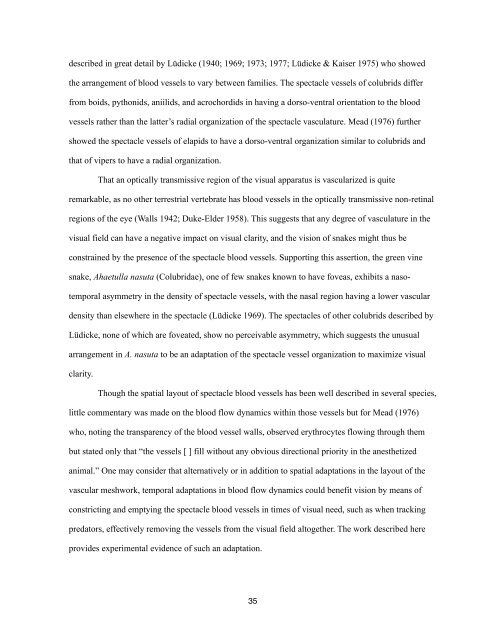Chapter 1, The Reptilian Spectacle - UWSpace - University of ...
Chapter 1, The Reptilian Spectacle - UWSpace - University of ...
Chapter 1, The Reptilian Spectacle - UWSpace - University of ...
You also want an ePaper? Increase the reach of your titles
YUMPU automatically turns print PDFs into web optimized ePapers that Google loves.
described in great detail by Lüdicke (1940; 1969; 1973; 1977; Lüdicke & Kaiser 1975) who showed<br />
the arrangement <strong>of</strong> blood vessels to vary between families. <strong>The</strong> spectacle vessels <strong>of</strong> colubrids differ<br />
from boids, pythonids, aniilids, and acrochordids in having a dorso-ventral orientation to the blood<br />
vessels rather than the latter’s radial organization <strong>of</strong> the spectacle vasculature. Mead (1976) further<br />
showed the spectacle vessels <strong>of</strong> elapids to have a dorso-ventral organization similar to colubrids and<br />
that <strong>of</strong> vipers to have a radial organization.<br />
That an optically transmissive region <strong>of</strong> the visual apparatus is vascularized is quite<br />
remarkable, as no other terrestrial vertebrate has blood vessels in the optically transmissive non-retinal<br />
regions <strong>of</strong> the eye (Walls 1942; Duke-Elder 1958). This suggests that any degree <strong>of</strong> vasculature in the<br />
visual field can have a negative impact on visual clarity, and the vision <strong>of</strong> snakes might thus be<br />
constrained by the presence <strong>of</strong> the spectacle blood vessels. Supporting this assertion, the green vine<br />
snake, Ahaetulla nasuta (Colubridae), one <strong>of</strong> few snakes known to have foveas, exhibits a naso-<br />
temporal asymmetry in the density <strong>of</strong> spectacle vessels, with the nasal region having a lower vascular<br />
density than elsewhere in the spectacle (Lüdicke 1969). <strong>The</strong> spectacles <strong>of</strong> other colubrids described by<br />
Lüdicke, none <strong>of</strong> which are foveated, show no perceivable asymmetry, which suggests the unusual<br />
arrangement in A. nasuta to be an adaptation <strong>of</strong> the spectacle vessel organization to maximize visual<br />
clarity.<br />
Though the spatial layout <strong>of</strong> spectacle blood vessels has been well described in several species,<br />
little commentary was made on the blood flow dynamics within those vessels but for Mead (1976)<br />
who, noting the transparency <strong>of</strong> the blood vessel walls, observed erythrocytes flowing through them<br />
but stated only that “the vessels [ ] fill without any obvious directional priority in the anesthetized<br />
animal.” One may consider that alternatively or in addition to spatial adaptations in the layout <strong>of</strong> the<br />
vascular meshwork, temporal adaptations in blood flow dynamics could benefit vision by means <strong>of</strong><br />
constricting and emptying the spectacle blood vessels in times <strong>of</strong> visual need, such as when tracking<br />
predators, effectively removing the vessels from the visual field altogether. <strong>The</strong> work described here<br />
provides experimental evidence <strong>of</strong> such an adaptation.<br />
35
















